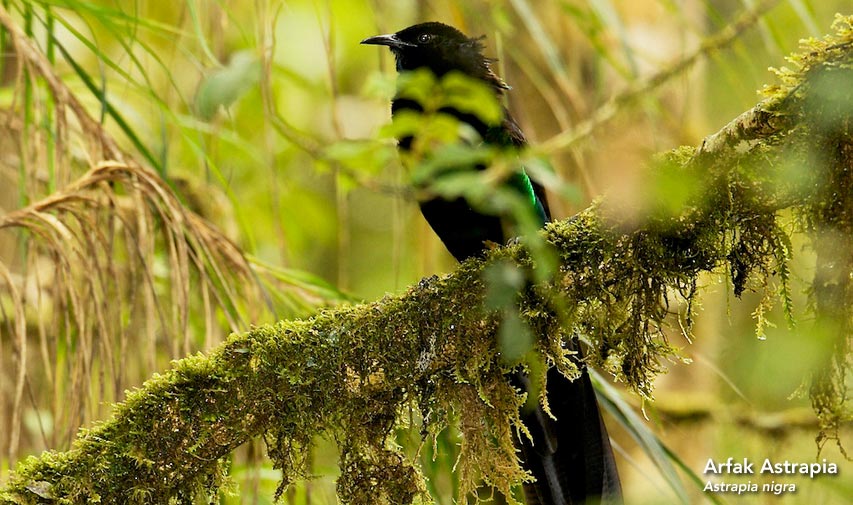Sound Gallery
Just as each species looks different, they sound different as well. Here are the voices of 17 bird–of–paradise species. Some have fairly harsh, simple voices much like the crows they are related to. Others have become mechanical, resonant, and even lovely. Listen to the different birds-of-paradise species or explore sound videos
Arfak Astrapia

Astrapias have very short, simple calls. This short click recorded during the project is the first-ever recording of the species’ voice. Sound: Like a person clicking his/her tongue. Watch this video to see how Ed and Tim used this recording to capture this image.
Carola’s Parotia

Most birds-of-paradise sing fairly short songs made up of short notes repeated quickly, unlike the elaborate melodies of many songbirds. Compared with other parotia species, this is a fairly complex call. Sound: a hurried, scratchy mix of three notes.
Western Parotia

Sound: A harsh parrot-like squawk, usually repeated two or three times in succession.
Standardwing Bird-of-Paradise

For species like this one that display in groups, even simple calls can turn into a complex racket when many males call at once. Sound: repeated nasal, upslurred notes.
Magnificent Bird-of-Paradise

Sound: Repeated throaty cheer-cheer-cheercheer-cheer or jeert-jeert-jeert-jeert.
Wilson’s Bird-of-Paradise

As if their vivid colors and meticulous displays weren’t enough, males spend inordinate amounts of time calling around their display courts. Sound: a loud, evenly paced, ringing series of whistled notes.
Brown Sicklebill

Several species make weird sounds that don’t really sound like a bird at all. The Brown Sicklebill sounds so much like a machine gun that during World War II, invading Japanese soldiers reportedly thought they were under attack. Sound: an unbirdlike, hollow rat-a-tat-at-at.
Black Sicklebill

Sound: Geographically variable—a very loud and fluid-sounding, two-note quink-quink or a faster, four-note wik-wik, wik-wik.
Pale-bill Sicklebill

Though its plumage is subdued, this species has one of the most musical songs found among the birds-of-paradise. Sound: an irregular series of loud, hollow, whistled notes.
Black-billed Sicklebill

Sound: A powerfully whistled and descending dyu-dyu-dyu-dyu-dyu that increases in speed as delivered.
Magnificent Riflebird

Not all sounds have to be made with a bird’s voice. In addition to the riflebird’s sweet whistled call, it makes a forceful rustling sound with its wings. Sound: a powerful, clear, rising whistle.
Goldie’s Bird-of-Paradise

This and other “plumed” birds-of-paradise display in groups in the canopy, where many males make excited yammering and bell-like calls. Sound: loud, drawn-out waah notes and abrupt, bell-like quong notes.
Blue Bird-of-Paradise

Sound: Nasal series of repeated wahwah notes and also a more resonant yaang-yaang-yaang.
Red Bird-of-Paradise

Sound: Loud, nasal wok-wok-wok or werk-werk that is repeated and variable in duration and tone.
Greater Bird-of-Paradise

Another of the spectacular “plumed” birds-of-paradise, this species also makes loud, excited calls during group displays in the canopy. Sound: loud wauk notes in a series of four, five, or more.
King-of-Saxony Bird-of-Paradise

Though it’s not musical, this bird’s complex, screeching song is one of the most extraordinary in the bird world. Sound: a decidedly un-birdlike mix of pulsing static, rattling, and screeching. Watch this video to see the outrageous-looking King-of-Saxony make a range of otherworldly calls.
Curl-crested Manucode

Male manucodes bypass colorful plumes and instead have remarkable internal anatomy: a greatly lengthened windpipe that functions as a wind instrument, giving their songs a beautiful, deeply resonant quality. Sound: a long, slow, trembling, slightly descending whistle. Watch this video to learn more.
